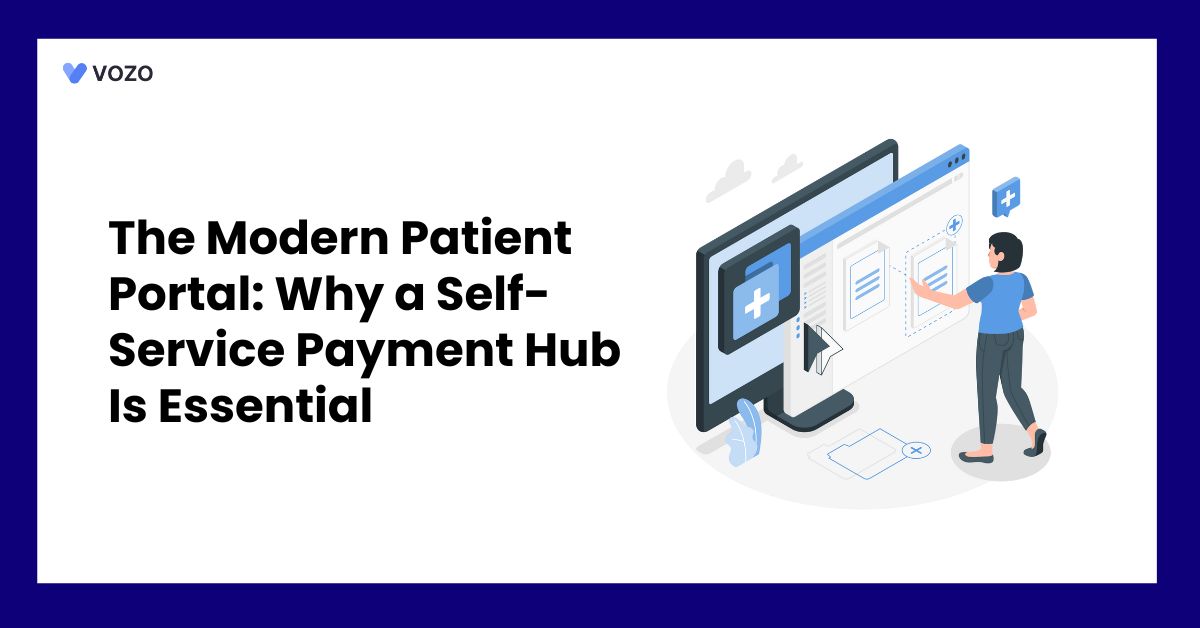The Modern Patient Portal: Why a Self-Service Payment Hub Is Essential
Patient portals have evolved into true “digital front doors” for healthcare, offering 24/7 online access to scheduling, records, messaging, and more. Today’s patients expect that same convenience when it comes to billing and payments. Surveys show roughly two-thirds of patients want to pay medical bills online.
At the same time, rising out-of-pocket costs (from high-deductible plans and drug prices) make patient payments a larger part of provider revenue.
The healthcare payments market is booming – one report projects the global digital healthcare payment market will reach about $55 billion by 2030, reflecting these shifting expectations. In short, integrating a robust self-service payment hub into the patient portal is no longer optional; it’s vital for meeting patient demand and modernizing the digital experience.
Key Benefits of a Self-Service Payment Hub
A self-service payment hub delivers multiple advantages for patients and providers alike:
1. Improved patient satisfaction and convenience
Patients can pay bills anytime, anywhere without mailing checks or making phone calls. Surveys consistently show a strong preference for online payment: for example, about 67% of patients say they prefer paying medical bills online. By enabling secure online payments,
- Card-on-file storage
- Mobile wallets (Apple Pay, Google Pay)
- Flexible payment plans right in the portal, providers meet these expectations.
One healthcare payment leader reports that adding such features led to a 20% increase in online payments and a smoother experience for patients. Modern, retail-like payment options in the portal thus boost convenience and patient satisfaction.
2. Enhanced revenue cycle and faster collections
Making it easy to pay online accelerates cash flow. Digital payments flow faster through the revenue cycle – for example, one provider group saw payments arrive roughly 6.5 days sooner on average when patients paid via the portal. Self-service adoption drives bigger yields too: in one case, portals enabled a 20–30% increase in patients paying online. Online billing also helps reduce bad debt.
A recent industry survey noted that about 40% of providers were experiencing rising bad debt, but experts emphasize that giving patients an easy online payment option can curb those losses. Automated reminders, convenient installment plans, and clear online billing all encourage patients to pay promptly, improving the bottom line.
3. Reduced administrative burden and call volume
A payment hub offloads routine tasks from staff. Electronic billing cuts paperwork and postage (one organization saw a 20–30% reduction in mailing costs) while sharply reducing manual processing.
- Reconciliation and accounting become far more efficient – RevSpring reports over 50% time savings for treasury teams when payments are processed digitally.
- And when patients can log in to see and pay their bills, there are fewer questions and disputes over the phone.
Collectively, this frees up staff from billing inquiries so they can focus on patient care. In short, a self-service hub streamlines operations and cuts overhead compared to handling every payment manually.
4. Increased transparency and patient engagement
Patients want clear, understandable bills. An online portal can show itemized charges, insurance payments, and patient balances all in one place.
- This transparency builds trust and engagement: according to recent data, 78% of patients say a provider’s billing process is an important factor when choosing care.
- If billing is confusing or cumbersome, patients notice – more than half (53%) of those who had a bad billing experience report posting a negative review for their provider.
Conversely, portals that integrate billing with patient communications (text/email reminders, e-statements) keep patients informed and engaged.
66% of consumers prefer receiving payment reminders by email or text, so a portal that automates those alerts can improve on-time payment and satisfaction. In short, giving patients an easy, transparent way to manage bills online strengthens their relationship with the provider.
Industry Trends and Patient Payment Preferences
Current trends strongly favor digital patient financial services:
1. Growing patient demand for digital payments
Surveys consistently show patients want online payment options. In addition to the 67% who prefer e-payments, about 62% of healthcare consumers report using patient portals to pay their bills.
Conversely, traditional methods are in decline: only about 11% of patients now pay by mailing a check, down from 17% a year earlier. Contactless and mobile payments are also on the rise – the share of patients preferring contactless payments doubled from 11% in 2021 to 22% in 2023. These shifts reflect the expectation that healthcare should offer the same payment conveniences as other industries.
2. Provider adoption and focus
Healthcare organizations are racing to meet this demand. A 2024 industry study found that 96% of providers now accept credit cards online and 69% offer flexible payment plans to help patients manage costs. Fully 80% of organizations identified upgrading billing and payment systems as a key focus area.
In other words, health systems know they must modernize the patient financial experience. Integrated payment platforms are becoming table stakes: they reduce friction and posting errors, and they offer a unified way to view all patient transactions.
3. Transparency, communication, and trust
Payment trends are also emphasizing transparency. For example, 72% of patients say they trust their healthcare provider (or its partners) to handle payment data securely, indicating willingness to pay electronically if trust is maintained. Healthcare leaders recognize that ensuring patients have real-time access to billing information boosts loyalty.
In one recent report, patients consistently ranked the billing experience as a driver of satisfaction, even saying billing can be as important as clinical care when choosing a provider. This means digital portals should not only enable payments, but also proactively keep patients informed with e-statements and reminders (which 66% of patients prefer).
4. Digital transformation and market growth
All signs point to the continued growth of healthcare payment technology. Research projects the U.S. digital healthcare payments market will expand rapidly – globally, it could reach ~$55 billion by 2030. Factors driving this include the ongoing consumerization of healthcare and the prevalence of high-deductible plans.
- As one healthcare payments expert notes, modern patient journeys now benchmark financial interactions against retail standards.
- Meaning the entire billing process needs to be seamless to meet consumer-grade expectations.
- In practice, this digital transformation encompasses everything from portal payment hubs to emerging tools like mobile wallets, billing chatbots, and AI-driven collections.
Together, these trends paint a clear picture: patients want convenient online payment experiences, and providers are responding. A self-service payment hub is central to this shift, enabling healthcare organizations to deliver digital billing, improve collection rates, and stay competitive.
Implementation Considerations of Payment Hub to a Patient Portal
When adding a payment hub to a patient portal, healthcare leaders should consider several critical factors:
1. Security and compliance
Patient payment data is highly sensitive. Any payment hub must use industry-standard security (PCI-DSS compliance, tokenization, and encryption of card data) and adhere to HIPAA privacy rules where applicable. Strong fraud prevention is essential.
As one recent report notes, securing patient payment information is paramount – successful systems allow patients to save payment methods securely and yet keep financial data protected. Look for platforms with advanced security certifications, audit trails, and the ability to detect anomalies.
2. Integration with EHR and billing systems
The portal’s payment hub should tie directly into the organization’s EHR and practice management systems. Seamless integration ensures payments post automatically to the correct accounts receivable records and that patient balances stay accurate. Experts caution that integration can be complex and is often a barrier for organizations.
To address this, many providers work with vendors offering fully integrated payment solutions that connect to the EHR. This approach provides a “360-degree view” from the patient’s online payment back to the hospital’s bank settlement, simplifying reconciliation and reducing errors.
3. Mobile-friendly user experience
Design the payment hub for smartphones and tablets as well as desktop browsers. A majority of patients use mobile devices to manage their healthcare, and mobile access is expected.
Surveys indicate that many patients aren’t even aware of mobile billing features – only about 57% reported having mobile access to billing statements in one study. A truly modern portal will be intuitive, load quickly on mobile, and guide the patient through payment in a few taps.
Key UX features include clear invoice views, the ability to split payments or set up installment plans, and one-click repeat payments. Offering multiple payment methods (credit card, debit, ACH/e-check, and popular digital wallets) in a single mobile-optimized page makes it much easier for patients to pay on the spot.
4. Flexible payment options and transparency
In addition to security and convenience, the system should offer flexibility. Patients increasingly expect features like saved cards, automatic recurring payments, and the option to pay via Venmo or PayPal.
Providers should also consider support for payment plans (monthly installments) to help patients manage larger bills. Equally important is transparent communication: the hub should send e-statements and text/email reminders automatically for new balances.
Given that two-thirds of patients prefer email or SMS billing reminders, integrating these channels reduces missed payments. Finally, the system should display detailed billing breakdowns (covered by insurance, patient responsibility, etc.) to reduce confusion and increase trust.
By carefully choosing a payment hub platform that addresses these considerations, healthcare organizations can ensure smooth implementation and high adoption rates among patients.
Related: The Ultimate Guide to Optimizing Patient Portals for Increasing Payment Collection
Vozo Patient Portal Solution
Vozo patient portal software provides a comprehensive solution to help healthcare providers achieve clinical, financial, and operational excellence through a powerful patient portal.
Our exceptional Patient Portal Software will allow:
- Have complete access to patients’ medical records digitally
- Our cost-effective subscription plan helps healthcare practices at all levels.
- The Vozo patient portal can effortlessly be integrated and implemented with any EHR system to increase productivity.
- Vozo’s Patient Portal respects users’ privacy and safeguards health-related records and personal information.
- 24/7 availability to support you with your needs and requirements.
- We will customize Vozo’s patient portal for a seamless workflow by understanding your unique needs for your specialty healthcare practice.
Patients can request appointments, access health records and lab results, and even pay bills online with the help of a patient portal, which creates a personal touch with you always.
Leverage the Vozo Patient Portal for Better Healthcare Solutions.
About the author

With more than 4 years of experience in the dynamic healthcare technology landscape, Sid specializes in crafting compelling content on topics including EHR/EMR, patient portals, healthcare automation, remote patient monitoring, and health information exchange. His expertise lies in translating cutting-edge innovations and intricate topics into engaging narratives that resonate with diverse audiences.













